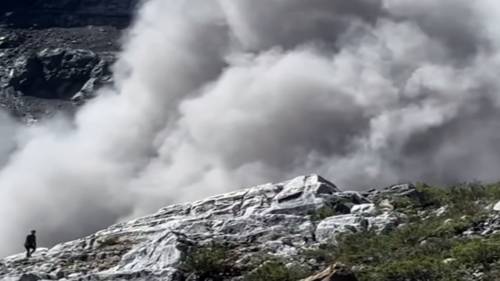The crisp morning air of July 22 still haunts the memories of those who witnessed tragedy unfold on Banff National Park’s iconic Lake Minnewanka shoreline. Three hikers lost their lives when an enormous rock slide sent boulders tumbling down without warning.
Almost two months later, Parks Canada has released its findings: the deadly slide was, in their assessment, completely unpreventable.
“This was a natural and spontaneous geological event that gave no warning signs,” explained Bill Hunt, Resource Conservation Manager for Banff National Park, during yesterday’s press conference. His voice carried the weight of delivering difficult conclusions to a public still searching for answers.
The slide, which occurred on a clear summer day, killed three visitors and injured two others who were hiking along the popular Stewart Canyon Trail. The victims, whose names were released with family permission, included Alberta residents Jessica Marlow and Thomas Chen, along with international visitor Lukas Schmidt from Germany.
Walking through the now-reopened trail yesterday, I spoke with several hikers who expressed mixed feelings about returning to the area. Calgary resident Marie Tremblay paused to look up at the rocky mountainside. “It makes you think about how powerful nature really is,” she said. “But I still feel safe knowing Parks staff did their due diligence.”
That due diligence involved an extensive geological assessment. According to Parks Canada’s 32-page report, specialists examined rock samples and historical data dating back 75 years. They found no evidence of previous instability in that particular section of mountainside.
The agency’s conclusion challenges what many Canadians might expect from our national parks system – that every risk can be identified and mitigated. Ron Hallman, CEO of Parks Canada, addressed this directly during a CBC Radio interview last week. “We inspect high-traffic areas regularly, but we cannot predict every geological event in a landscape that’s fundamentally dynamic and ever-changing.”
Some park visitors remain unconvinced. At the Lake Minnewanka boat launch, I met Edmonton resident Patrick Wong, who questioned whether more could have been done. “Three people died. Someone should have seen signs of instability,” he insisted.
However, University of Calgary geologist Dr. Sarah McPherson supports Parks Canada’s conclusion. “Rock slides can occur without warning, especially in mountainous terrain experiencing seasonal freeze-thaw cycles,” she explained. “The science is clear that some geological events simply cannot be predicted with current technology.”
The tragedy has sparked renewed discussions about risk in wilderness settings. Parks Canada reports visitation to Rocky Mountain parks has increased 27% since 2019, bringing more people into potential contact with inherent wilderness hazards.
Banff Mayor Corrie DiManno has called for balance in the conversation. “We want visitors to enjoy our spectacular landscapes while understanding that wilderness contains elements beyond human control,” she told me during a phone interview. “This tragic event reminds us of nature’s unpredictability, but shouldn’t deter responsible recreation.”
For the families of those lost, these explanations offer little comfort. Their legal representative, Martin Schultz, released a statement indicating they’re reviewing Parks Canada’s findings before commenting publicly.
The Stewart Canyon Trail has reopened with additional warning signage, though the specific slide area remains off-limits as further assessments continue. Park staff have also conducted additional inspections of similar geological features throughout Banff’s trail system.
This summer’s tragedy joins a sobering list of natural hazard incidents in Canada’s mountain parks. Last year saw seven visitor fatalities across the mountain parks, though none from rock slides. According to Parks Canada statistics, the agency manages approximately 48 million visitor days annually across its sites, with serious incidents remaining statistically rare.
As Canadians grapple with this reminder of wilderness unpredictability, the conversation extends beyond Banff. Provincial parks across the country are reviewing their own risk assessment protocols, according to the Canadian Parks Council.
Standing at the trailhead yesterday, watching visitors cautiously return to Stewart Canyon Trail, I was struck by the delicate balance Parks Canada must maintain – preserving natural processes while providing reasonable safety for millions of visitors.
“We come to places like Banff precisely because they aren’t engineered environments,” reflected Linda Morin, a Quebec visitor I met photographing the scenery. “That means accepting some level of risk, doesn’t it?”
Perhaps that’s the uncomfortable truth at the heart of this tragedy. In our quest to experience Canada’s wild places, we must acknowledge that not every risk can be eliminated. The rocks will continue their slow journey downward, following geological timelines that occasionally, tragically, intersect with human ones.






